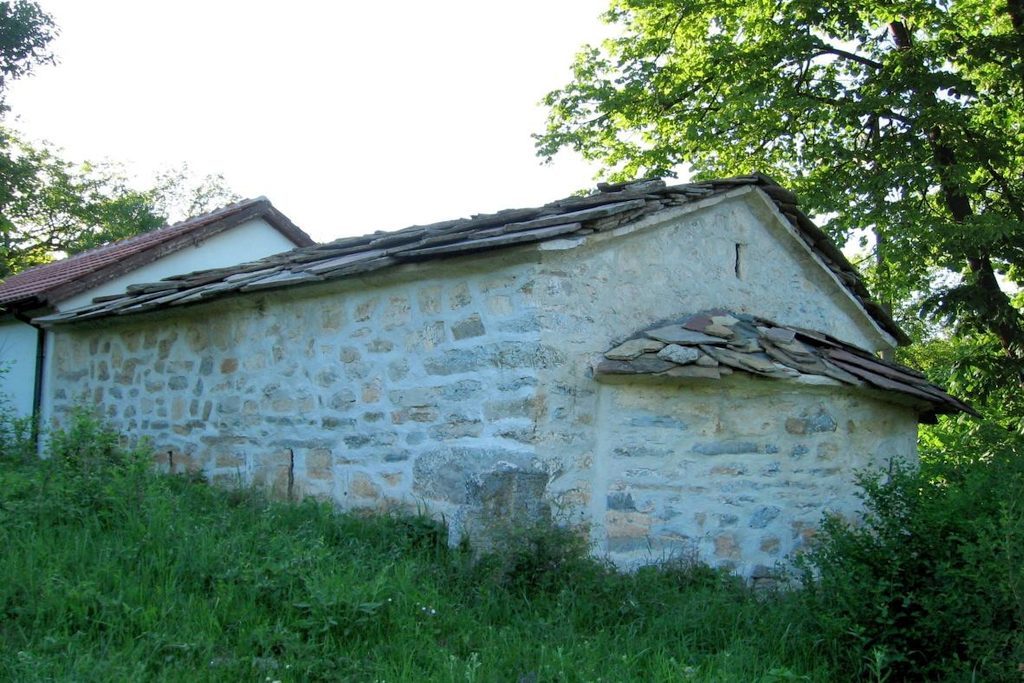

Medieval church “St. Nicholas” in Gorna Verenitsa is high in the south part of the village, located on a hill of Broad Mountain, so it opens a spectacular view to the north. There is no indication when it was built this church, but identity of its architecture with that of “St. Nicholas’ – Dolna Cerenitsa suggests that it must have been not later than XVI-XVII century. To reach its present form, the church has under gone two construction period – the first was built east of the old and the second includes building of the narthex to the west in 1848. Murals of the temple was late, judging by an inscription on the left of the front door, it is made in rebuilding the church in 1848. The murals are the work of Yanachko Stanimirov village of Breze, Sofia, he is the author of some of the frescoes in Iskretski monastery.
From the architectural point of view the medieval church is a basilica structure, dug three feet into the ground and with a the western entry. There are three small windows (for ventilation), two in the south and one on the north wall. The church has a cylindrical vault also covered with flagstones. The robust masonry is of stones plastered with mortar. The entire interior was painted with frescoes, with few exceptions; the author adhered to the Orthodox canon, the same way he respected the modest size of the temple. The apse shell is commonly for “Maria Shirshaya” provincial temples – the image of the Virgin Mary with baby Jesus in her arms. Above the author painted the Holy Trinity. At the bottom of the apse are described six figures of the church parents, including among the fathers St. Gregory the Theologian, St. Basil the Great, St. John Chrysostom also St. Athanasius. The vault is divided into three parts, each showing the incarnation of Christ. According to the Canon, the middle field is given to Christ Pantocrator, the western image of the arc represents the God of Armies, the traditional triangular nimbus, and on the east was presented the image of Christ Emmanuel. The next interesting point of temple decoration shows images of the four evangelists accompanied by their symbols. On the north wall are the evangelists Luke and Matthew with their calf and an angel and the south wall, just behind the site of the altar wall is painted Mark the Evangelist, and his symbol is a lion. From the picture of St. John the Theologian and his corresponding eagle, because of the devastating impact of moisture over the years, unfortunately there was nothing left.
In the two registers of the above, in rainbow arch, are presented some of the most important evangelical scenes. It is presented a small part of the life of Jesus Christ. Along the southern and northern wall is presented an ongoing cycle of the life of Mary Gospodski. On the west wall of the temple, just above the entrance is the composition “Garden of Eden”, which is part of the “doomsday”. In the center is the almighty God, and in the two sides are placed two characters, and in all likelihood one of them is Jacob and the other one is Abraham or the Abraham’s bosom – an expression that marks the place where the souls of the righteous will enjoy happiness and rest after leaving this world. The iconographic program continues with images of some of the most popular saints, including Ivan Rilski and St. George, and the patron of the temple is honored with some of the most characteristic scenes from his life.
Of particular interest in the decoration of the temple is represented by the portrait of the donor. One is located on the south wall and depicts a man and a woman with three children, parents hold in their hands a model of the building (then the newly built church with narthex). The clothes and hairstyles are very realistic painted, typical of the time (the man with an earring and tassel behind the door). In the background, above them we can read the following inscription: “Kti’tora Andrea Li’liny Mitsarkova woman Pr’va ego and emu cha’da Petry Mary Todora.” The other portrait was painted in the window thickness, on the south. Both are dressed in the ecclesiastical clothing, and wrote: “Bocan old priest” “It’s …. Nicolas Ierey trustee”.
In conclusion, we can say that the mural paintings within the church, although they are not artistic achievements of medieval painting, are systematic, structured and distinct. They are characterized by simplicity and clarity, orderly, harmonious and easily accessible. They fully comply with the world from that time, that used to pray. The wooden iconostasis, with the exception of a frieze carved along its entire length, is simply very well done. The iconostasis icons are now missing (not in the temple) were evacuated by Hristo Obrazopissetsa Koprivshtica between 1891 and 1897.
Currently, the old church from Upper Verenitsa was renovated outside, the roof was renovated, the leaks are stopped. The murals, sometimes quite damaged by moisture, need restoration. It would be better to explore if under the mural painting are other old paintings (medieval ones), as it is in dolnoverenishkata church of “St. Nicholas”.
